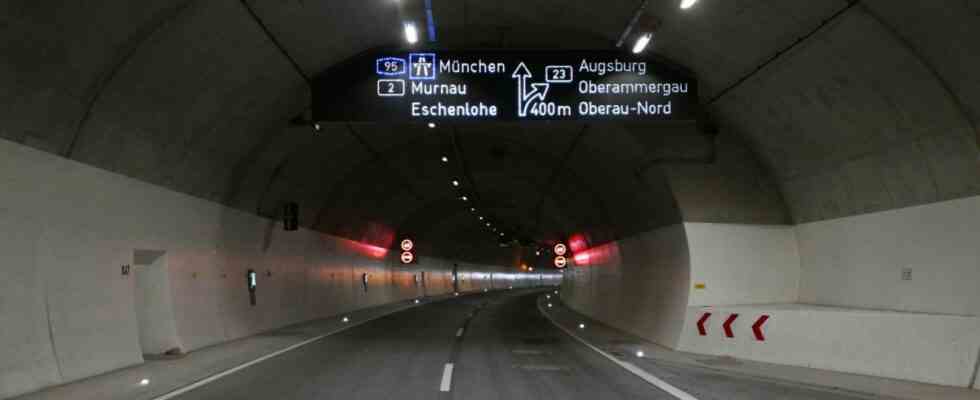The last thing the workers did on Monday was weld all the brand new manhole covers back on. This is not standard in road construction, because such covers are basically there to be opened occasionally. But the new bypass tunnel around the village of Oberau in the narrow Loisachtal near Garmisch-Partenkirchen is something special. Not only because, at almost three kilometers, it is the longest road tunnel in Bavaria. In any case, it will only remain so until the 600 meter longer Garmisch bypass tunnel through the Kramer is completed a few kilometers to the south in two or three years. But in a few weeks, the tunnel around Oberau will also be part of the approach route to the G-7 summit at Schloss Elmau, hence the welded gullies to be on the safe side. Although the tunnel has been under construction for much longer than there is talk of a second summit in Elmau, the work is now over in time. The Oberau Tunnel will be officially opened this Thursday. And all around, planning, digging and blasting continues.
Because the heavy traffic, 45,000 cars on peak days, will no longer flow through Oberau, but through the Mühlberg and the Kirchbichl and also under the Gießenbachtal, where the B 23 from Oberammergau and Ettal comes down next to the stream. The route continues southwards through the Farchant bypass tunnel, which was completed in 2000 – and then either through Garmisch in the direction of the Fern Pass or through Partenkirchen in the direction of Mittenwald and Innsbruck.
Next through the Wank?
From the point of view of the local residents, there is therefore no way around a Wank tunnel around Partenkirchen. There has been a current preliminary draft for him for a few weeks, after initial considerations from the 1970s disappeared in the drawer, as did a plan from 2011 – at that time with a view to the 2018 Winter Olympics, but then not due to a lack of enthusiasm among the citizens in Munich and Garmisch-Partenkirchen. The Kramer tunnel around Garmisch has also been in the mind of the engineers since the 1970s, plans were ready in 2007, and in 2009 the Administrative Court dismissed the last complaint by the Federal Nature Conservation Agency (BN), which wanted a different route.
Alexander Dobrindt (CSU), as Federal Transport Minister at the time, released the construction of the Oberau Tunnel again a few days before the 2017 federal elections.
(Photo: Sven Hoppe/dpa)
Construction began in Kramer in 2010, but three years later – as predicted by BN experts – water entered the exploratory tunnel. The construction site stood still until the local member of the Bundestag and then Federal Transport Minister Alexander Dobrindt (CSU) released the construction again a few days before the 2017 federal election. The main tube has been completely broken through since the end of October, and at the beginning of April this year it was finally possible at the watery problem area in the former exploratory tunnel, which is to serve as a rescue tunnel in the future.
All of these tunnel projects are intended to prevent a new bottleneck from forming in the respective location when the excessive holidaymakers, excursionists, skiers, commuters and through traffic regularly roll through the Loisach Valley. Another tunnel north of Oberau could finally pull the cork out of the bottle. At the notorious “Autobahnend bei Eschenlohe” – a classic of traffic reports on the radio – the heavy traffic has to merge onto the B 2 heading south. In the future, however, it will be routed from the A 95 through the Auerberg Tunnel, which is currently under construction, directly to the north portal of the new Oberau Tunnel.
No money for the train
While for some the chain of tunnels is only then complete and traffic can finally flow freely, many critics see exactly that as a problem. Because the easier the traffic flows, the more cars there could be in the Loisachtal and in Garmisch-Partenkirchen – especially since the rush of day-trippers is getting bigger and there is talk of a real expansion of the single-track Werdenfelsbahn at best in the form of lip service. The state government has not reported the expansion to the federal government as a priority project, and Deutsche Bahn has even sold basic strips that would be necessary for a second track in certain sections.
For the many road tunnels, however, one billion euros in total costs will in all likelihood not be enough. The Oberau tunnel, which was calculated at a good 200 million euros, will instead cost around 260 million euros – about as much as is initially calculated for the Kramer tunnel. The Weilheim road construction authority currently estimates the Wank tunnel at 306 million euros, while the Auerberg tunnel is said to cost 170 million. All of this has earned local MP Alexander Dobrindt the title “Tunnel God” in the local newspaper. He will be one of the opening guests in Oberau, as will Bavaria’s Minister of Transport, Christian Bernreiter (CSU).
In the village, resentment was recently voiced that during maintenance work in one of the two tunnel tubes, half of the traffic will possibly drive through Oberau again, because the ventilation of the tubes would have cost several million more for oncoming traffic. Finally, it was about this or that not being on the guest list for the opening ceremony. But two hours later, the tunnel is open to the general public anyway: first for the Oberau running group, then for cyclists, skaters and pedestrians. Some guests may even come by train. The first cars should then roll on Friday.

